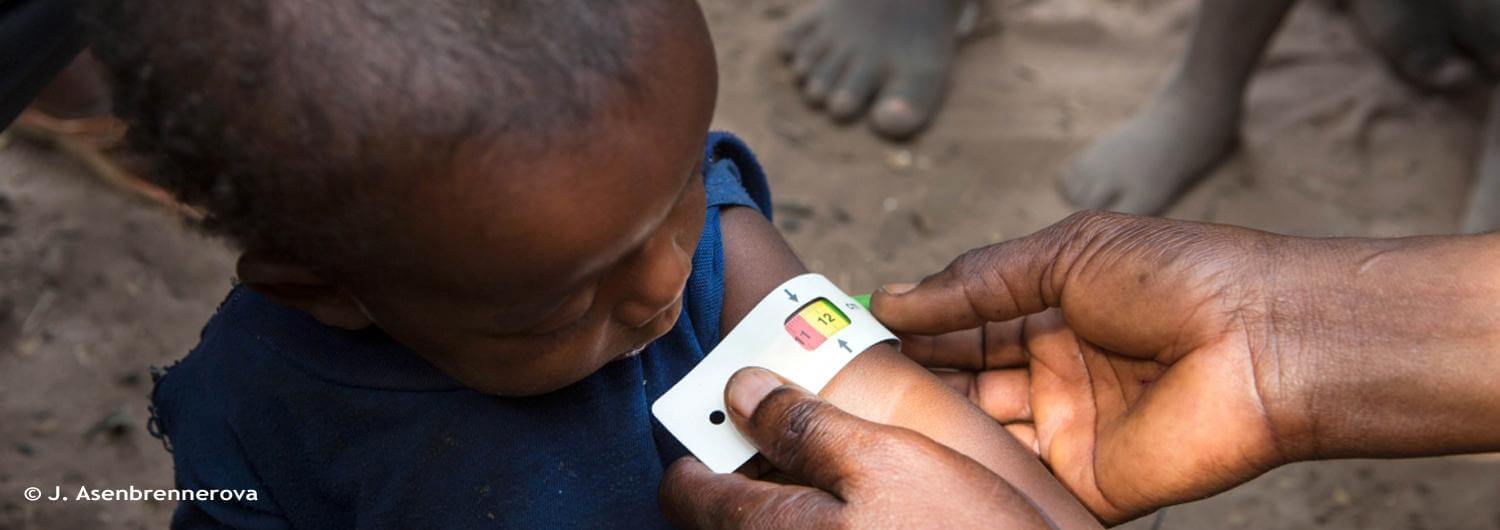News
In Development: Game-Changing Tool for Diagnosing Undernutrition
30/12/15

Simple “click” bracelet will improve accuracy and empower moms and caregivers to screen their children
Editor's Note: The international humanitarian and development community will soon have a hugely important and impactful new tool at its disposal that will empower mothers and community members to screen their children for acute undernutrition. Today, many frontline health workers use a simple color-coded plastic band to measure "mid-upper arm circumference" (MUAC), which allows them to quickly assess whether a child is acutely undernourished and in urgent need of treatment. The MUAC measurement is effective, easy to perform, and requires minimal equipment, making it extremely valuable for community-based health workers serving remote areas.
The colors on the MUAC band signal the child's nutritional status: if the girth of the arm measures within the green part of the band, that indicates that the child is adequately nourished. A measurement within the yellow zone means the patient is at risk of acute undernutrition. A measurement in the red zone indicates that the child is acutely undernourished and in need of immediate, lifesaving therapeutic treatment. Although MUAC bands are simple and effective, they are not foolproof. If the band is too loose or too tight, the measurement will be inaccurate, which means that some children will not be properly diagnosed and referred for proper treatment. To ensure that more children are accurately screened and treated for acute undernutrition, Action Against Hunger is working with the University of Tampere School of Medicine and Michigan Technological University to research and develop a more effective MUAC tool.
An estimated one million children die every year from severe acute undernutrition. The new tool, which will be called the "Click MUAC," could be a breakthrough for identifying children who need lifesaving care. Far fewer severely undernourished children will fall through the cracks. Here's what our Technical Director, Silke Pietzsch, has to say about the project:
"The Click MUAC could revolutionize the way we estimate the nutritional status of children. It will give us an opportunity to reduce the level of error in measuring mid-upper arm circumference, and thus reduce errors in the numbers of children that are excluded from treatment programs. This would also improve our ability to ensure we are using our often very limited resources for nutrition treatment programs as effectively as possible, especially in emergencies.
If we are successful with the development of this new tool, we will make major strides in increasing the number of undernourished children we reach—with correct diagnosis and referrals to health centers. This could mean that every mom of a child under five years of age would be empowered to correctly identify whether her child is acutely undernourished at any point in time, and be able to make the informed decision to take her child to the health center for treatment and health services."
Read our Q&A to learn more about the Click MUAC development project. (The Q&A, slightly modified for style below, was originally published online by the Humanitarian Innovation Fund, and may be read in its original form there.)
What is the humanitarian need?
There are an estimated 19 million children suffering from severe acute undernutrition (SAM) in the world today. However, globally, approximately 85 percent of severely undernourished children still lack access to treatment. A key component in managing SAM is establishing regular, sufficient community-level detection and screening of children who are undernourished. However, this often entails relying heavily on community volunteers (CVs) and community health workers (CHWs) to conduct SAM screenings. Because CVs and CHWs are often responsible for many kinds of community health activities, they are often juggling competing priorities—and they require regular training to empower them to deliver effective support. Another issue contributing to high rates of SAM is that many mothers and primary caregivers lack an understanding of the warning signs and causes of undernutrition, and as a result, they do not know when to seek treatment for their children.
A new approach has been piloted recently that involves training mothers and caregivers to measure their child's mid-upper arm circumference (MUAC) to detect severe undernutrition. Although initial results have been very encouraging, they also highlight the need to develop a means of standardizing the measurement of MUAC to increase the sensitivity and the specificity of the diagnosis delivered by mothers and primary caregivers.
What is the innovative solution?
This project will address these challenges by developing a simplified, standard MUAC measurement bracelet. The new MUAC tool will be highly sensitive and easy-to-use— requiring minimal training for mothers and primary caregivers with low levels of literacy. The MUAC measurement is the most common form of anthropometric [human body measurement-focused] measurement used at community level for the detection of SAM, and it considered one of the best proxy (indirect) indicators for mortality in children between the ages of 6 to 59 months.
What are the expected outcomes?
This innovation has the potential to play a significant role in improving the coverage of SAM case detection and therefore the uptake of SAM treatment. This new tool is expected to improve SAM diagnosis at community level, which would lead to greater accuracy of referrals of children in urgent need of treatment to health centers. In addition, previous evidence has demonstrated that when mothers are empowered to monitor their own child’s nutrition status, they are more likely to take the child for treatment in a timely manner. Early treatment at the health center improves a child's chances of recovery.